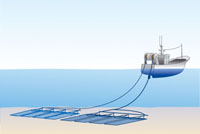 Dredging on the seabed for shellfish uses metal-framed baskets instead of nets. These baskets are criss-crossed with steel rings and a set of metal teeth is attached to a raking bar held beneath the basket. A heavy netting cover is laced to the frame to form a pouch in which the catch is retained. Up to 14 frames may be fixed to a tow bar, with two bars towed from the back or sides of a vessel. The metal teeth rake out shellfish from the sand and gravel and the shellfish are collected into the pouch.
Dredging on the seabed for shellfish uses metal-framed baskets instead of nets. These baskets are criss-crossed with steel rings and a set of metal teeth is attached to a raking bar held beneath the basket. A heavy netting cover is laced to the frame to form a pouch in which the catch is retained. Up to 14 frames may be fixed to a tow bar, with two bars towed from the back or sides of a vessel. The metal teeth rake out shellfish from the sand and gravel and the shellfish are collected into the pouch.
Examples of target species
- Scallops, oysters and clams.
Environmental summary
- Habitat damage - damage and disturbance to the seabed, as well as bottom living marine animals, occurs as the fishing gear is towed along the ocean floor. The heavy metal gear of dredgers has come under scrutiny for habitat damage. The damage is related to the size and weight of the dredge.
- Bycatch of vulnerable species - dredging has the potential to unintentionally catch vulnerable species.
- Discards - dredging can be associated with bycatch of non-target fish and other marine life. The accidental catch and discarding of juvenile commercial fish species can impact on these populations.
Mitigation
New toothless dredges can reduce the impact of dredging on seabed habitat and are being used in some UK fisheries.
Good Catch: Good Catch provides practical information for chefs, caterers and restaurateurs, making it easier for them to serve more sustainable seafood.
